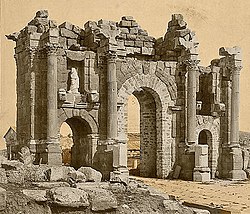 Ruins of Madauros | |
| Location | Algeria |
|---|---|
| Region | Souk Ahras Province |
| Coordinates | 36°04′36″N7°49′12″E / 36.076667°N 7.82°E |
Madauros (Madaurus, Madaura) was a Roman-Berber city and a former diocese of the Catholic Church in the old state of Numidia, in present-day Algeria.

